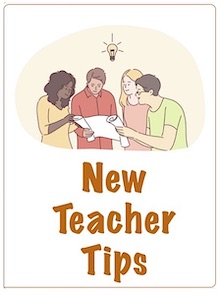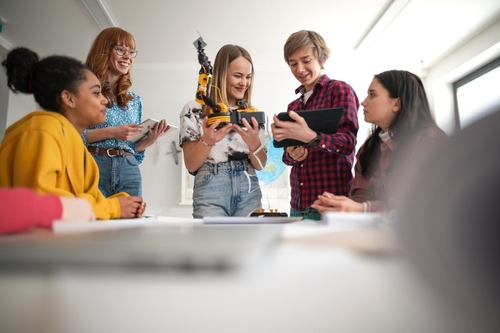A MiddleWeb Blog
 As an educator, I firmly believe in blending fun, learning, and assessment. That’s why I enjoy helping new and preservice teachers discover ways to engage students in “stealth” learning – using real-world challenges, simulations, and games to develop and assess knowledge and skills – often without students even realizing it (Rahimi & Shute, 2024).
As an educator, I firmly believe in blending fun, learning, and assessment. That’s why I enjoy helping new and preservice teachers discover ways to engage students in “stealth” learning – using real-world challenges, simulations, and games to develop and assess knowledge and skills – often without students even realizing it (Rahimi & Shute, 2024).
Though stealth tasks don’t have to be digital, I usually introduce teachers to the concept by asking them to download a free, popular game/simulation like Build A City: Community Town from the Apple or Android store where they take on the role of city planners, tasked with constructing and managing a growing community.
As they struggle to make decisions about resource allocation, infrastructure, housing, public services, and environmental sustainability, they develop – and demonstrate – skills in budgeting, solving citizen complaints, and planning for future expansion.

Here are some stealth learning and assessment ideas for different curriculum areas – and some general tips for designing stealth learning activities. They work for experienced teachers, too!
Examples of Stealth Learning and Assessment
Authentic, fun challenges that embed assessment into practical application of knowledge and skills can be found in just about every content area. For example…
In science, students could design and build a birdhouse to meet specific criteria (e.g., predator-proof, weatherproof, attractive to a certain species). This requires researching the bird species’ needs (entrance hole size, nesting materials, location) and applying engineering principles to create a functional birdhouse.
Stealth assessment can be achieved through observation of student interactions during the design and building process, analyzing the completed birdhouses for functionality and adherence to criteria, and reviewing student journals or presentations for evidence of critical thinking and knowledge acquisition.
Foreign language students could engage in a cooking competition that fosters language acquisition through hands-on experience. Students learn culinary vocabulary, enhance reading comprehension by following recipes, and improve speaking fluency by collaborating and communicating.
Assessment could involve observing student interactions, evaluating the final product, and incorporating peer feedback to assess their language proficiency.
In math, students can work to redesign a playground for their school while trying to adhere to budget and space constraints. As they do so, work on valuable skills like calculating area and perimeter, and figuring out the cost of materials. They might even have to work with proportions and ratios as they scale down their designs.
Embedded assessment can be achieved by observing student collaboration, analyzing their design process and budget proposals, and evaluating the clarity and effectiveness of their presentations.
In English Language Arts, students could collect family recipes and work together to compile and edit them into a class cookbook. Doing so would require them to develop skills such as writing clear instructions, using precise language and applying clear punctuation. They could even design the layout and cover.
Assessment of the class cookbook project can be conducted by observing student collaboration and communication, analyzing the clarity and accuracy of the written recipes, and evaluating the overall presentation of the cookbook. This approach assesses writing skills, critical thinking, and creativity within a collaborative and authentic learning experience.
Social studies teachers could set up a mock trial based on a historical event or legal case. Students would research their assigned roles, develop arguments, and present their cases in a courtroom setting. This activity encourages critical thinking, research skills, public speaking, and understanding of the legal system or historical context. The focus is on the drama and challenge of the trial, but students learn about history, civics, and argumentation along the way.
Stealth assessment for this might involve observing student research, argument development, and courtroom presentation skills. This includes assessing their ability to conduct thorough research, develop persuasive arguments, communicate effectively, and collaborate with others.
There are, of course, plenty of digital stealth activities available for free to teachers and students. Often they take the form of games or simulations. Some of my recent favorites include…
Working With Water: This turn-based strategy web game helps students explore the challenges of maintaining a sustainable water supply system. Throughout the game the need for clean drinking water increases as the community grows, and the student is responsible for building new infrastructures to meet the increased demand.
Global Pandemics: This is a fantastic free Chrome app that transports teachers and students back in time and into the lives, choices, and dilemmas faced by individuals during some of the largest scale plagues and pandemics in history.
MissionUS: This simulation allows teachers and students to be immersed in rich, historical settings. Players develop historical knowledge and use it to make difficult social, political, and economic decisions faced by individuals in various time periods.
Key Components and Design of Stealthy Activities
Regardless of the content area, stealth learning and assessment should possess the following key attributes and characteristics (Shute & Kim, 2014):
- student investment in authentic, real-world tasks and projects
- acquisition of knowledge and skills that occur naturally as students engage in activities…often without being explicitly aware that they are being taught
- exploration, problem-solving, and collaboration
- the ability to stealthily gather evidence on students’ progress as they interact with each on the learning task
- opportunities for the teacher to adjust difficulty, provide hints, and offer personalized feedback
Designing a stealth learning task isn’t as difficult as it sounds. Educators looking to get started might follow these steps:
1. Clearly define your learning objectives. Be sure to identify what skills and knowledge students should develop and how they will demonstrate understanding.
2. Choose an engaging context. Use simulations, games or real-world problem-solving to immerse students in meaningful tasks.
3. Design and embed assessment into the task. Remember that assessment can take place through observation of student problem-solving, discussions, and other subtle tools that track learning without formal testing.
4. Build in opportunities for feedback to help guide students in real-time.
5. Keep it low-stakes and focus on smaller steps and provide lots of chances to try things again. Be sure to allow multiple attempts, emphasize growth, and use assessment to guide rather than to grade.
6. Be patient, reflect, and improve. Remember that your first attempt at stealth learning and assessment is unlikely to work out exactly as planned. Gather data and ask for feedback from students. Use this information to refine future tasks.
Naturally, some educators are more comfortable and adept at designing and implementing learning experiences like those described above. For the rest – if not MOST – of us, it’s helpful to get some assistance. I’ve found it useful to collaborate with other educators who can share ideas and valuable insight.
It’s also okay to get a bit of help from AI like Google Gemini, CoPilot or ChatGPT. With some wordsmithing, AI tools can be prompted to brainstorm a wide range of creative and engaging task ideas, help creating authentic scenarios/contexts, and even provide suggestions for assessment and feedback. Here’s an example:
Prompt: Assume the role of an educator working to design a stealth learning and assessment task for ____ grade students in _______ (enter your content area). The learning outcomes you want to address are ______________ (enter your learning outcomes). Please generate 5 different ideas for a stealth (1) learning task and (2) assessment ideas that (a) reflect authentic, real-world tasks and/or projects, (b) help students to naturally acquire knowledge and skills throughout the task (c) promote exploration, problem-solving, and/or collaboration, (d) allow the teacher to stealthily gather evidence on students’ progress throughout the task learning task, and (e) provide opportunities for the teacher to adjust difficulty, provide hints, and offer personalized feedback.
While not all of AI’s suggestions will be great, one or two are bound to get your creative juices flowing.
Putting It All Together
In conclusion, stealth learning and assessment blur the boundaries between learning, assessment, and fun. Whether through games, simulations, or practical projects, students gain knowledge while enjoying the process. This approach makes learning more relevant and authentic, and allows students to develop skills without feeling like they are being assessed.
Designing stealth learning activities requires clear objectives and thoughtful planning. It also allows us to provide students real-time feedback through observation and interaction. As teachers, we can foster student growth while ensuring tasks are engaging and purposeful. With a bit of support from fellow educators and AI tools, each of us can find ways to refine our approach and create authentic, dynamic learning experiences.
References
Rahimi, S., & Shute, V. J. (2024). Stealth assessment: a theoretically grounded and psychometrically sound method to assess, support, and investigate learning in technology-rich environments. Educational technology research and development, 72(5), 2417-2441.
Shute, V. J., & Kim, Y. J. (2014). Formative and stealth assessment. Handbook of research on educational communications and technology, 311-321.


